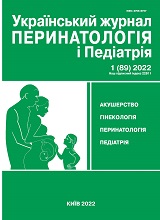Rubinstein-Taybi syndrome in neonatal practice (case report)
DOI:
https://doi.org/10.15574/PP.2022.89.31Keywords:
Rubinstein-Taybi syndrome, craniofacial abnormalities, digit abnormalities, newbornsAbstract
The article presents data on a rare genetic disease - Rubinstein-Taybi syndrome. The disease incidence is 1: 25000-1: 30000. Parents’ lifestyle has no influence on the birth of a child with Rubinstein-Taybi syndrome. The risk of having a second child with the same pathology is 0.1%. The syndrome is characterized by the presence of deformed digits, distinctive facial features and mental retardation. Clinical signs of the disease occur as a result of mutation in the gene encoding a specific GreB protein. This gene is localized on the chromosome 16. The article reports on the main phenotypic deviations and analyzes the literature data on somatic and neurological pathologies. The syndrome is characterized by a combination of delayed physical and psychomotor development, progressive intellectual disability, characteristic craniofacial dysmorphism, deformity of digits (namely broad, short and wide distal phalanges of the thumbs and big toes, sometimes distal phalanges of other fingers and toes), abnormalities of the cardiovascular, respiratory and urogenital systems.
The article presents primary data on the diagnosis of Rubinstein-Taybi syndrome in a child of neonatal age. The boy’s parents, young people, and the newborn’s sister, aged 3, are healthy. No phenotypic manifestations of skeletal dysplasia were detected. The relatives’ hereditary history is negative. We have observed the following facial dysmorphia: low forehead, low hair growth line, high-arched eyebrows, moon-shaped face, hypertelorism, downward slanted eyes, «beaked» nose, hypoplastic nasal wings, moderate retrognathia, high narrow palate, dysplastic, small, low-lying auricles. Broad terminal phalanges of thumbs and big toes, as well as valgus deformity of the thumbs were observed. The child was diagnosed with an open aortic duct and congenital choanal atresia on the right.
Thus, a severe disabling pathology in a child born to apparently healthy parents indicates a sporadic de novo mutation.
The research was carried out in accordance with the principles of the Helsinki declaration. The informed consent of the patient was obtained for conducting the studies.
No conflict of interests was declared by the authors.
References
Bartsch O, Kress W, Kempf O. (2010). Inheritance and variable expression in Rubinstein-Taybi syndrome. Am J Med Genet. 152A: 2254-2261. https://doi.org/10.1002/ajmg.a.33598; PMid:20684013
Chernenkov YuV, Eiberman AS, Belova HIu, Maltseva LA. (2016). Syndrom Rubynshteina-Teiby u rebenka chetirekh let: opysanye klynycheskoho sluchaia. Saratovskyi nauchno-medytsynskyi zhurnal. 12 (4): 578-581. https://doi.org/10.12968/denn.2016.12.10.578
Korzus E. (2017). Rubinstein-Taybi Syndrome and Epigenetic Alterations. Adv Exp Med Biol. 978: 39-62. https://doi.org/10.1007/978-3-319-53889-1; PMid:28523560
Kosaki R. (2017). Rubinstein-Taybi syndrome. Nihon Rinsho. 75 (3): 498-503.
Kozlova SY, Demykova NS. (2007). Nasledstvennыe syndromы y medyko-henetycheskoe konsultyrovanye. Atlas-spravochnyk. 3-e yzd. Tovaryshchestvo nauchnыkh yzdanyi KMK: 448. ISBN 978-5-87317-387-7.
Milani D, Manzoni F, Pezzani L. (2015). Rubinstein - Taybi syndrome: clinical features, genetic basis, diagnosis, and management. Italian Journal of Pediatrics. 41 (4): 234-239. https://doi.org/10.1186/s13052-015-0110-1; PMid:25599811 PMCid:PMC4308897
Naye Choi, Hwa Young Kim, Byung Chan Lim, Jong-Hee Chae, Soo Yeon Kim, Jung Min Ko. (2021). Genetic and clinical heterogeneity in Korean patients with Rubinstein - Taybi syndrome. Mol Genet Genomic Med. 9 (10): 1791. https://doi.org/10.1002/mgg3.1791; PMid:34427995 PMCid:PMC8580098
Shevchenko OA. (2014). Syndrom Rubinshteina-Teibi v pediatrychnii nevrolohii. Perynatolohiia i pediatriia. 1 (57): 59-67. https://doi.org/10.15574/PP.2014.57.59
Spena S, Gervasini C, Milani D. (2015). Ultra-Rare Syndromes: The Example of Rubinstein-Taybi Syndrome. J Pediatr Genet. 4 (3): 177-186. https://doi.org/10.1055/s-0035-1564571; PMid:27617129 PMCid:PMC4918723
Van Gils J, Magdinier F, Fergelot P, Lacombe D. (2021). Rubinstein-Taybi Syndrome: A Model of Epigenetic Disorder. Genes (Basel). 12 (7): 968. https://doi.org/10.3390/genes12070968; PMid:34202860 PMCid:PMC8303114
Downloads
Published
Issue
Section
License
Copyright (c) 2022 Ukrainian Journal of Perinatology and Pediatrics

This work is licensed under a Creative Commons Attribution-NonCommercial 4.0 International License.
The policy of the Journal “Ukrainian Journal of Perinatology and Pediatrics” is compatible with the vast majority of funders' of open access and self-archiving policies. The journal provides immediate open access route being convinced that everyone – not only scientists - can benefit from research results, and publishes articles exclusively under open access distribution, with a Creative Commons Attribution-Noncommercial 4.0 international license(СС BY-NC).
Authors transfer the copyright to the Journal “MODERN PEDIATRICS. UKRAINE” when the manuscript is accepted for publication. Authors declare that this manuscript has not been published nor is under simultaneous consideration for publication elsewhere. After publication, the articles become freely available on-line to the public.
Readers have the right to use, distribute, and reproduce articles in any medium, provided the articles and the journal are properly cited.
The use of published materials for commercial purposes is strongly prohibited.

